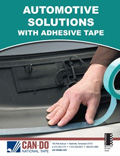
A variety of lightweight materials are popular in automotive manufacturing today in part because they can be engineered to lessen the potential for fire, smoke, and toxicity. These include:
- Carbon Foam
- Non-Woven Fabrics and Fibers
- Lightweight Metals
- High Performance Plastics
Conventional fasteners and fastening methods often do not work well with these new, lighter-weight materials. Newly-designed adhesive materials are well-suited to the task, due to their low-profile and weight, high bonding level, and their ability to bond dissimilar surfaces. Furthermore, these adhesive materials can be developed with a flame-retardant treatment for FMVSS standard 302 compliance.
Not only do flame-retardant adhesive tapes and materials enhance the safety of light-weight automotive assemblies, they greatly improve manufacturing efficiencies and safety. Today, materials can be bonded without the need for welding, hole-punching, and other costly or complicated processes.
To learn more how adhesive tapes and materials are addressing the challenges within the automotive industry, download our free guide, Automotive Solutions with Adhesive Tape.

